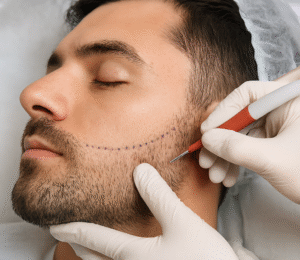Beard Transplant: Your Guide to Safe, Effective, International Treatment
International patients seeking a beard transplant need accurate, reassuring guidance. With WMEDTour, navigating procedure choices, managing related health conditions like pelvic organ prolapse, and organizing travel logistics becomes smooth, well-structured, and trustworthy.

Understanding Beard Transplant Options
Choosing between FUE (Follicular Unit Extraction) and FUT (Follicular Unit Transplantation) depends on scarring tolerance, donor area availability, recovery time, and desired appearance. Both methods are effective, but they differ in approach and recovery.
FUE vs. FUT — What’s Best?
| Procedure | Pros | Cons |
|---|---|---|
| FUE | No linear scar; quicker recovery; discreet results | Higher cost; longer procedure time |
| FUT | Harvests more grafts quickly; cost-effective | Linear scar; longer downtime |
Important Considerations for International Patients
Safety & Quality of Clinics
WMEDTour’s verified hospital network ensures all listed facilities meet high standards for safety, hygiene, and patient satisfaction. We connect you with clinics that provide multilingual staff and specialized care for medical tourists.
Pelvic Organ Prolapse and Cosmetic Procedure Planning
Patients managing pelvic organ prolapse often wonder whether additional cosmetic procedures could pose risks. Our specialists review your complete medical history, provide second opinions, and ensure your care plan is safe and personalized.
Cost Factors and Treatment Planning
International treatment costs depend on factors such as number of grafts, anesthesia, surgeon expertise, and location. Learn more about cost breakdowns. We provide transparent pricing that includes travel, accommodation, and local support—so you can focus on recovery.
Why Trust WMEDTour?
- Expert consultation — Choose the right transplant method for your needs.
- Second opinion services — Especially valuable for patients with other health conditions.
- Treatment coordination — We connect you with world-class doctors.
- Travel & accommodation support — Seamless arrangements for medical tourists.
Recommended WMEDTour Resources
- About WMEDTour
- Hair Transplant Abroad
- FUE Hair Transplant
- FUT Hair Transplant
- Cosmetic Surgery Abroad
- DHI Hair Implant
- Medical Tourism in Iran
- Best Country for Hair Transplant
- Contact Us
- Patient Reviews
Trusted External References
- Istanbul Hair Center
- Clínica Imagen – Mexico
- Asia Hair Clinic – Thailand
- Cleveland Clinic International
- Sinclair Clinics – Australia
- Healthline: Beard Transplant Guide
- WebMD: Hair Transplant Overview
- Mayo Clinic: Hair Transplant
- ASPS: Hair Transplantation
- NIH: Beard Hair Transplant Study
FAQs
1. What is a beard transplant?
A beard transplant is a surgical procedure where hair follicles are taken from a donor area (usually the scalp) and implanted into facial areas to create fuller beards or fill patchy spots.
2. How long does a beard transplant last?
Results are permanent because transplanted follicles continue to grow hair naturally for life.
3. Is a beard transplant painful?
The procedure is performed under local anesthesia, so discomfort is minimal. Mild soreness may occur during recovery.
4. How much does a beard transplant cost internationally?
Prices vary widely by country, clinic reputation, and graft numbers—typically ranging from $2,000 to $7,000.
5. Can I have a beard transplant if I have pelvic organ prolapse?
Yes, but only after a medical evaluation to ensure no procedure interferes with your prolapse treatment plan.
6. How long is the recovery period?
Most patients resume normal activities within 3–5 days, with full healing over 2–3 weeks.
7. Will the results look natural?
Yes, when performed by skilled surgeons, the hair direction, density, and angle are customized to match your natural growth pattern.
8. What are the risks?
Risks are minimal but may include swelling, redness, and rare infection—easily managed with proper care.
9. How do I choose the right clinic abroad?
Look for internationally accredited facilities with experienced surgeons, transparent pricing, and positive patient reviews.
10. How soon can I shave after surgery?
It’s recommended to wait at least 2–3 weeks before shaving to avoid disturbing new grafts.
Take the Next Step
At WMEDTour, we help patients access the best pelvic organ prolapse treatments and cosmetic procedures like beard transplants. From expert consultation to travel arrangements, we make your journey safe and stress-free.
Ready to start? Contact WMEDTour today and take your first s



